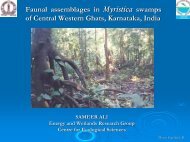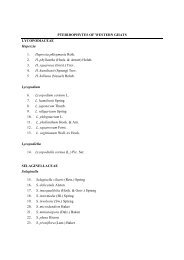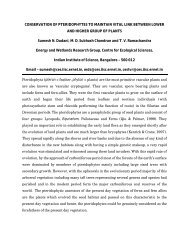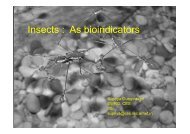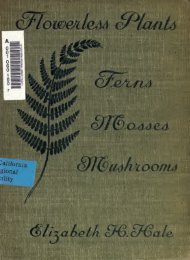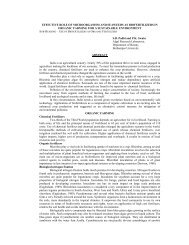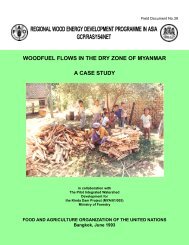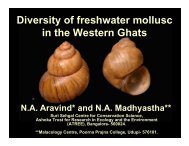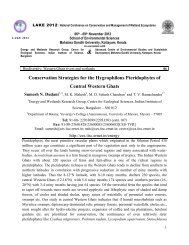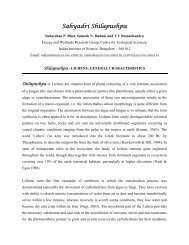a brief comp a brief comparison of modern pteridophyte arison of ...
a brief comp a brief comparison of modern pteridophyte arison of ...
a brief comp a brief comparison of modern pteridophyte arison of ...
You also want an ePaper? Increase the reach of your titles
YUMPU automatically turns print PDFs into web optimized ePapers that Google loves.
C. R. Fraser-Jenkins : A Brief Comp<strong>arison</strong> <strong>of</strong> Modern Pteridophyte Classifications (Families and Genera in India) 115<br />
and Chinese pteridologists began again, that Ching and subsequently his followers, who <strong>of</strong>ten<br />
took up many <strong>of</strong> his unpublished herbarium-names, had named a massive excess <strong>of</strong> erroneous<br />
new species, based on minor growth and developmental variation, but alongside many<br />
genuine new species, as would be expected. A few <strong>of</strong> the authors <strong>of</strong> the Chinese Flora<br />
managed to investigate and sink an important initial swathe <strong>of</strong> these names in certain genera<br />
(but not in others such as the now almost intractable genera, Cyrtomium and Arachniodes).<br />
But that work still has to continue a great deal further and in addition proper taxonomic<br />
balance will have to be maintained in order to understand and interpret the new results from<br />
moleculology in a meaningful and appropriate way. The challenges facing mainland Chinese<br />
pteridology are thus far greater at present than in other parts <strong>of</strong> the world, the first step<br />
required being a large-scale <strong>modern</strong>isation <strong>of</strong> the old splitting system <strong>of</strong> classification instead<br />
<strong>of</strong> the obligation to maintain it more-or-less rigidly (with only occasional minor revisions<br />
allowed here and there from moleculology). A recent paper (Lu & Yang 2005) setting out<br />
to "revise" Taiwanese <strong>pteridophyte</strong>s according to the mainland Chinese system was a quite<br />
ironic and unnecessary, <strong>comp</strong>lete reversal <strong>of</strong> what actually needs to be done, as was<br />
abundantly clear to most pteridologists in Taiwan when it was published.<br />
Fortunately taxonomic research is able to continue actively in mainland China,<br />
despite its near demise and starvation <strong>of</strong> funds in most other countries and there is thus<br />
considerable hope that a new approach may come in there before long, which need not even<br />
depend on molecular work, providing some rather fundamental decisions and much rethought<br />
can take place. In the meantime it continues to be necessary for workers elsewhere to<br />
"translate" the nomenclature <strong>of</strong> the Chingian system into a more international context in<br />
order to be able to assimilate the many continuing and valuable Chinese pteridological<br />
publications that are frequently so relevant floristically to Indian pteridology. The first<br />
indications that this might be about to happen is given in a paper by Liu et al. (2008) who<br />
published their acceptance and support <strong>of</strong> Smith et als. (2006) classification for families.<br />
However it is therefore somewhat surprising to find a new paper by Qi et al. (2009),<br />
involving some <strong>of</strong> the same authors, continuing to utilise Ching’s system, perhaps as an<br />
indication that the necessary change may come rather slowly and may not at first turn out<br />
to be as far-reaching as is required, especially for genera. It is also perhaps rather<br />
disappointing merely to see the moleculological cladological classification being adopted<br />
wholesale rather than being modified here and there by some non-cladistic, taxonomic and<br />
morphological considerations, where appropriate.<br />
TABLE ABLE OF OF F FFAMIL<br />
F AMIL AMILY AMIL Y AND AND GENERIC GENERIC N NNAMES<br />
N AMES<br />
SUGGESTED SUGGESTED SUGGESTED FOR FOR INDIAN INDIAN SUBCONTINENT<br />
SUBCONTINENTAL SUBCONTINENT AL PTERIDOPHYTES<br />
PTERIDOPHYTES<br />
In the following table the author has set out a scheme largely based on Kramer &<br />
Green (1990), with certain modifications including from Smith et al. (2006) and some other<br />
modifications <strong>of</strong> his own, recognising 34 families and 135 genera. In general some <strong>of</strong> the<br />
more surprising changes put forward by Smith and other N. American molecular workers



